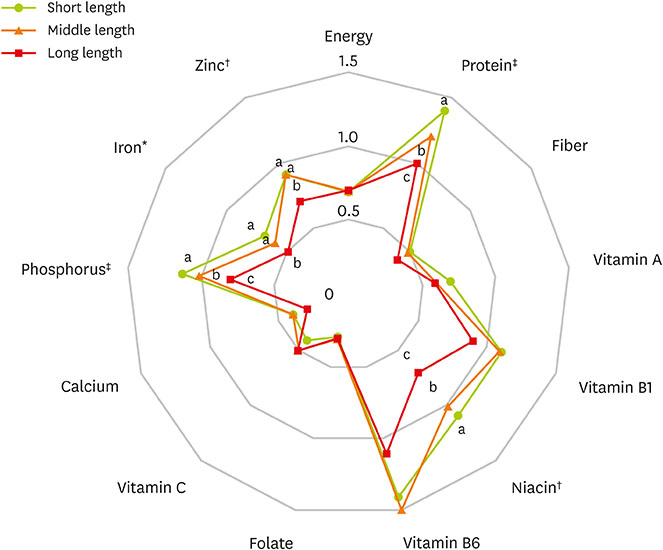Clin Nutr Res.
2018 Jul;7(3):178-188. 10.7762/cnr.2018.7.3.178.
Changes in Dietary Quality among Vietnamese Women Immigrants in Korea and Comparison with Korean Women
- Affiliations
-
- 1Department of Medical Nutrition, Graduate School of East-West Medical Science, Kyung Hee University, Yongin 17104, Korea. hjlim@khu.ac.kr
- 2Research Institute of Medical Nutrition, Kyung Hee University, Seoul 02447, Korea.
- KMID: 2417714
- DOI: http://doi.org/10.7762/cnr.2018.7.3.178
Abstract
- The dietary behavior of immigrants starts changing upon their arrival in a new country. We evaluated changes in dietary quality of Vietnamese women immigrants in Korea and compared dietary quality with that of Korean women. Fifty-six Vietnamese women immigrants and 56 age-matched Korean women were recruited. Dietary quality were assessed using index of nutritional quality (INQ) and diet quality index-international (DQI-I). Dietary habits were assessed according to 4 dietary behaviors: a prudent, calorie control, dietary fat control, and sodium or salt control diet. DQI-I scores of Vietnamese immigrants decreased after immigration, especially the moderation score, although the variety score increased. Scores were significantly lower than those of Korean subjects (45.1 vs. 64.5; p < 0.001). Vietnamese women immigrants had significantly poorer nutrient balance and calorie intake control, although their fat and sodium control was better than that of Korean woman (p < 0.001). INQs of protein, niacin, phosphorus, iron, zinc were lower in immigrants who had lived longer in Korea than more recent immigrants (p < 0.05). Lower INQs of protein, fiber, vitamin A, B1, B6, C, folate, and phosphorus were related to higher body fat in Vietnamese immigrants (p < 0.05). In conclusion, dietary quality of Vietnamese immigrants decreased after migration, and dietary intake was inadequate compared with that of Korean women. In addition, diet quality of Vietnamese immigrants decreased with length of residence in Korea. There was a negative correlation between diet quality and body fat percent in Vietnamese women immigrants. Findings from this study may help improve diet quality and prevent obesity in Vietnam women immigrants.
Keyword
MeSH Terms
Figure
Reference
-
1. Korean National Statistical Office. The statistics of foreigner in Korea. 2017. cited 2018 March 30. Available from http://kostat.go.kr.2. Kim SH, Kim WY, Lyu JE, Chung HW, Hwang JY. Dietary intakes and eating behaviors of Vietnamese female immigrants to Korea through marriage and Korean spouses and correlations of their diets. Korean J Community Nutr. 2009; 14:22–30.3. Cahe OH, Hong DA. Case study for Vietnamese marriage immigrants' adjustment to Korea. Korean J Hum Ecol. 2007; 16:61–73.
Article4. Lyu JE, Yang YJ, Lee SE, Chung HW, Kim MK, Kim WY. Nutritional status of Vietnamese female marriage immigrants to Korea in relation to length of residence in Korea. Ann Nutr Metab. 2009; 55:317–324.
Article5. Kim S, Haines PS, Siega-Riz AM, Popkin BM. The Diet Quality Index-International (DQI-I) provides an effective tool for cross-national comparison of diet quality as illustrated by China and the United States. J Nutr. 2003; 133:3476–3484.
Article6. Kant AK, Block G, Schatzkin A, Ziegler RG, Nestle M. Dietary diversity in the US population, NHANES II, 1976–1980. J Am Diet Assoc. 1991; 91:1526–1531.
Article7. Lee O, Kim J, Lee H, Choue R. Nutritional status, quality of diet and quality of life in postmenopausal women with mild climacteric symptoms based on food group intake patterns. Korean J Community Nutr. 2012; 17:69–80.
Article8. Stephen F. Austin State University. Nutrition questionnaire. cited 2009 May 15. Available from http://www.sfasu.edu/campusrec/documents/nutritional-questionnaire.pdf.9. Vuong TN, Gallegos D, Ramsey R. Household food insecurity, diet, and weight status in a disadvantaged district of Ho Chi Minh City, Vietnam: a cross-sectional study. BMC Public Health. 2015; 15:232.
Article10. Khan SA, Jackson RT, Momen B. The relationship between diet quality and acculturation of immigrated South Asian American adults and their association with metabolic syndrome. PLoS One. 2016; 11:e0156851.
Article11. Kim SH, Choi HN, Hwang JY, Chang N, Kim WY, Chung HW, Yang YJ. Development and evaluation of a food frequency questionnaire for Vietnamese female immigrants in Korea: the Korean Genome and Epidemiology Study (KoGES). Nutr Res Pract. 2011; 5:260–265.
Article12. Kim JM, Lee NH. Analysis of the dietary life of immigrant women from multicultural families in the Daegu area. J Korean Diet Assoc. 2009; 15:405–418.13. Park SY, Murphy SP, Sharma S, Kolonel LN. Dietary intakes and health-related behaviours of Korean American women born in the USA and Korea: the Multiethnic Cohort Study. Public Health Nutr. 2005; 8:904–911.
Article
- Full Text Links
- Actions
-
Cited
- CITED
-
- Close
- Share
- Similar articles
-
- Analyzing Factors Influencing the Quality of Life in Vietnamese Married Immigrant Women in Korea
- Comparison of Needs for Pregnancy and Postpartum Adaptation of Chinese Immigrant Women and Vietnamese Immigrant Women in South Korea
- Development of Nutrition Education Program for Vietnamese Female Marriage Immigrants in Korea Based on the Health Belief Model
- Influence of Spousal Support on the Relationship between Acculturative Stress and Sense of Parenting Competence among Married Vietnamese Immigrant Women
- Maternal Conflicts of Vietnamese Married Immigrant Women in Korea


